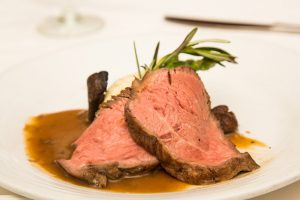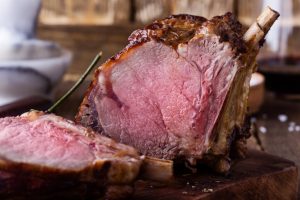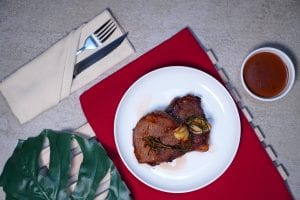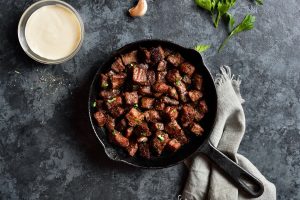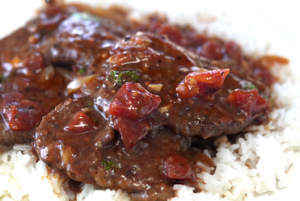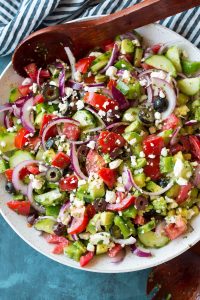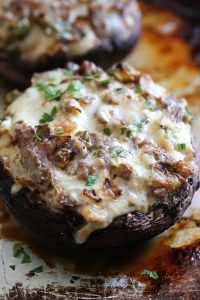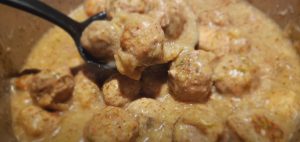The reverse-sear steak recipe delivers a perfectly cooked and delicious steak every time. The secret to this mouthwatering dish is slow-roasting the steak first, then searing it to create a flavorful crust. This method ensures that the steak is succulent and tender on the inside, with a beautifully browned exterior.
Photos of Reverse-Sear Steak Recipe
Most ingredients for this recipe are commonly found in home kitchens. The rib eye steak is a prime cut of beef that you might need to specially purchase from a supermarket or a butcher's shop. It's known for its rich, beefy flavor and is incredibly juicy and tender when cooked properly. Another ingredient to note is canola oil, which is preferred over olive oil for its high smoke point, making it suitable for searing.
Ingredients for the Reverse-Sear Steak Recipe
Rib eye steak: This is a beef steak from the rib section. The rib eye is known for its rich, beefy flavor and it's incredibly juicy and tender when cooked properly.
Salt: Enhances the flavor of the steak and helps form a nice crust when searing.
Pepper: Adds a bit of heat and complexity to the beef's flavor.
Canola oil: Used for its high smoke point, perfect for searing the steak at high temperatures.
Butter: Adds richness and helps in basting the steak to keep it juicy and flavorful.
Garlic: Infuses the steak and butter with a warm, savory flavor.
Rosemary: This herb adds an earthy, woody flavor that complements beef well.
Thyme: Imparts a subtle, savory flavor to the steak.
One reader, Filide Mckeon says:





This reverse-sear steak recipe is a game-changer! The steak turned out perfectly juicy and tender. The slow baking method really locks in the flavors, and the final sear adds a beautiful crust. The garlic and herb butter took it to the next level. It's now my go-to steak recipe!
Mastering the Techniques for a Reverse-Sear Steak Recipe
How to reverse-sear a steak: This technique involves slow-cooking the steak in the oven at a low temperature before finishing it with a high-heat sear. This method ensures a perfectly cooked steak with a beautifully caramelized crust.
How to season the steak: Generously season all sides of the steak with salt and pepper to enhance its flavor.
How to sear the steak: Sear the steak in a hot pan with canola oil to create a flavorful crust on the outside while keeping the inside tender and juicy.
How to baste the steak: Basting the steak with butter, garlic, and herbs adds extra flavor and moisture to the meat during the searing process.
How to check the internal temperature: Use a meat thermometer to check the internal temperature of the steak to ensure it reaches the desired level of doneness.
How To Make Reverse-Sear Steak
The reverse-sear steak involves baking the steak in the oven before searing on a pan. It creates a caramelized & browned crust and a more tender meat.
Serves:
Ingredients
- 1thick rib eye steak,(2-inch thick), preferably USDA prime
- 1tspsalt,to taste
- 1tsppepper,to taste
- 3tbspcanola oil
- 2tbspbutter
- 2clovesgarlic,peeled and smashed
- 2sprigsfresh rosemary
- 3sprigsfresh thyme.
Instructions
-
Preheat oven to 200 degrees F.
-
Pat the steak dry with a paper towel, and generously season all sides of the steak with salt and pepper.
-
Transfer to a wire rack on top of a baking sheet, and bake for about 45 minutes to 1 hour, until the internal temperature reads about 125 degrees F for medium-rare. Adjust the bake time for rare or well-done steak.
-
Heat the canola oil in a pan over high heat until smoking. Do not use olive oil, as its smoke point is significantly lower than that of canola oil and will smoke before reaching the desired cooking temperature.
-
Sear the steak for 1 minute on one side, then flip.
-
Add the butter, garlic, rosemary, and thyme, and swirl around the pan. Transfer the garlic and herbs on top of the steak and baste the steak with the butter using a large spoon.
-
Baste for about 1 minute, then flip the steak with tongs and baste the other side for about 15 seconds.
-
Turn the steak on its side and cook to render off any excess fat.
-
Enjoy!
Nutrition
- Calories: 749.41kcal
- Fat: 67.86g
- Saturated Fat: 24.32g
- Trans Fat: 2.73g
- Monounsaturated Fat: 32.66g
- Polyunsaturated Fat: 8.06g
- Carbohydrates: 4.06g
- Fiber: 1.76g
- Sugar: 0.05g
- Protein: 33.06g
- Cholesterol: 149.53mg
- Sodium: 521.26mg
- Calcium: 63.60mg
- Potassium: 487.60mg
- Iron: 4.48mg
- Vitamin A: 124.28µg
- Vitamin C: 9.23mg
Expert Advice for Perfecting Your Reverse-Sear Steak Technique
When searing your steak, it's crucial to have your pan extremely hot. This ensures a nice, crispy crust on the exterior of the steak. However, be careful not to burn the butter when you add it to the pan. If the butter starts to burn, lower the heat slightly. The butter should be foamy and golden, not dark and burnt. This will give your steak a rich, nutty flavor without any bitterness.
Time-Saving Tips for Preparing a Reverse-Sear Steak
Prep ahead: Prepare the seasoning and herbs in advance to save time during the cooking process.
Room temperature: Allow the steak to come to room temperature before cooking to ensure even cooking and reduce cooking time.
Resting time: Let the steak rest after cooking to allow the juices to redistribute, resulting in a juicier and more flavorful steak.
Sharp knife: Use a sharp knife to cut the steak, making it easier and quicker to slice and serve.
Quality ingredients: Use high-quality, well-marbled steak for better flavor and texture, requiring minimal seasoning and cooking time.
Proper equipment: Use a meat thermometer to accurately gauge the steak's doneness, saving time and ensuring perfect results.
Substitute Ingredients For Reverse-Sear Steak Recipe
rib eye steak - Substitute with New York strip steak: New York strip steak is also a tender and flavorful cut of beef that works well for reverse-searing.
canola oil - Substitute with vegetable oil: Vegetable oil has a similar smoke point and neutral flavor, making it a suitable substitute for canola oil.
butter - Substitute with ghee: Ghee is clarified butter with a nutty flavor and high smoke point, making it a great substitute for butter in high-heat cooking methods like reverse-searing.
garlic - Substitute with shallots: Shallots provide a mild, sweet onion flavor that can complement the steak without overpowering it.
fresh rosemary - Substitute with fresh thyme: Fresh thyme can provide a similar earthy and aromatic flavor to the dish.
fresh thyme - Substitute with dried thyme: Dried thyme can be used as a substitute for fresh thyme, but use it in smaller quantities as it is more concentrated in flavor.
Presenting the Perfect Reverse-Sear Steak
Perfectly seared steak: The steak should be perfectly seared to a beautiful golden brown color on the outside, with a juicy and tender pink center when sliced.
Garnish with fresh herbs: Sprinkle the plate with fresh rosemary and thyme to add a pop of color and a hint of freshness to the dish.
Elevate with compound butter: Top the steak with a slice of homemade compound butter infused with garlic and herbs, adding a luxurious and flavorful touch.
Accompany with roasted garlic: Serve the steak with a side of roasted garlic, adding a sweet and mellow flavor that complements the richness of the steak.
Present on a wooden cutting board: For a rustic and elegant presentation, serve the steak on a wooden cutting board, allowing the natural beauty of the dish to shine through.
Accompany with a red wine reduction: Drizzle a rich and velvety red wine reduction on the plate to add depth and complexity to the dish, enhancing the flavors of the steak.
Serve with a side of truffle mashed potatoes: Accompany the steak with a luxurious side of creamy truffle mashed potatoes, adding a touch of indulgence to the overall presentation.
Garnish with edible flowers: Add a touch of sophistication by garnishing the plate with delicate and colorful edible flowers, enhancing the visual appeal of the dish.
Essential Tools for Making a Reverse-Sear Steak
- Oven: An appliance used for baking, roasting, and heating food.
- Wire rack: A metal rack used for cooling baked goods or as a support for roasting meat.
- Baking sheet: A flat, rectangular metal pan used for baking and roasting in the oven.
- Pan: A cooking vessel with a handle and typically a lid, used for frying, searing, and sautéing.
- Tongs: A utensil with two arms and a pivot used for gripping and lifting food items.
- Paper towel: An absorbent paper used for drying and cleaning food items and surfaces.
- Spoon: A utensil consisting of a small bowl and a handle, used for stirring, serving, and basting.
Storing and Freezing Your Reverse-Sear Steak
- Let the steak rest for 5-10 minutes before storing to allow the juices to redistribute.
- Wrap the cooled steak tightly in plastic wrap or aluminum foil to prevent air exposure and moisture loss.
- Place the wrapped steak in an airtight container or resealable plastic bag.
- Label the container or bag with the date and contents for easy identification.
- Store the steak in the refrigerator for up to 3-4 days.
- For longer storage, place the wrapped steak in a freezer-safe container or resealable plastic bag, removing as much air as possible.
- Label the container or bag with the date and contents.
- Freeze the steak for up to 2-3 months for optimal quality.
- To thaw, transfer the frozen steak from the freezer to the refrigerator and allow it to thaw overnight.
- Reheat the thawed steak in a preheated oven at 275°F (135°C) until it reaches the desired internal temperature, or enjoy it cold in salads or sandwiches.
- Avoid refreezing previously frozen and thawed steak to maintain its texture and quality.
How To Reheat Leftover Reverse-Sear Steak
The best way to reheat a reverse-seared steak is to slowly warm it in the oven. Preheat your oven to 250°F (120°C) and place the steak on a wire rack over a baking sheet. This allows the heat to circulate evenly around the meat, preventing it from steaming and losing its crispy exterior.
Before reheating, let the steak sit at room temperature for about 20-30 minutes. This helps the meat reheat more evenly and prevents it from becoming tough or overcooked.
Brush the steak with a thin layer of olive oil or butter to help maintain its moisture and prevent it from drying out during the reheating process.
Place the steak in the preheated oven and reheat for about 20-30 minutes, depending on the thickness of the cut. Use a meat thermometer to check the internal temperature; aim for 110°F (43°C) for medium-rare or 130°F (54°C) for medium.
If you prefer a quicker method, you can reheat the steak in a cast-iron skillet over medium heat. Add a small amount of butter or oil to the pan and sear the steak for about 1-2 minutes on each side, just until it's heated through.
For an even faster approach, microwave the steak on 50% power in 30-second intervals until it reaches the desired temperature. However, be cautious as this method can easily overcook the meat and make it tough.
Regardless of the reheating method you choose, let the steak rest for a few minutes before serving to allow the juices to redistribute throughout the meat. This ensures a juicy, flavorful steak that tastes almost as good as when it was first cooked.
Interesting Trivia About the Reverse-Sear Steak Recipe
Reverse-sear steak is a cooking method that involves slow-cooking the steak in the oven before finishing it with a quick sear on the stovetop. This technique allows for a more even cook and a tender, juicy steak.
Is Making a Reverse-Sear Steak at Home Cost-Effective?
This reverse-sear steak recipe is moderately cost-effective for a household. The main expense is the rib eye steak, but the method of cooking ensures a perfectly cooked steak, making it worth the investment. The use of canola oil and butter is economical, and the addition of garlic and herbs enhances the flavor without adding significant cost. The approximate cost for a household of 4 people is around $30-$40, depending on the quality of the steak. Overall Verdict: 9/10
Is the Reverse-Sear Steak Recipe Healthy or Unhealthy?
The reverse-sear steak recipe, while undeniably delicious, is not the healthiest option due to its high saturated fat content from the rib eye steak and butter. The generous seasoning of salt also contributes to a higher sodium intake. However, the recipe does incorporate some beneficial ingredients, such as garlic, rosemary, and thyme, which offer antioxidants and anti-inflammatory properties.
To make this recipe healthier, consider the following suggestions:
- Opt for a leaner cut of beef, such as sirloin or tenderloin, to reduce the overall fat content
- Reduce the amount of butter used or replace it with a healthier alternative like olive oil or avocado oil
- Use less salt in the seasoning and instead focus on enhancing the flavor with more herbs and spices like garlic powder, onion powder, or smoked paprika
- Serve the steak with a side of nutrient-dense vegetables, such as roasted broccoli, asparagus, or a fresh salad, to balance out the meal and add fiber, vitamins, and minerals
By making these adjustments, you can still enjoy a flavorful and satisfying steak dinner while being mindful of your overall health and well-being.
Editor's Opinion on the Reverse-Sear Steak Recipe
This reverse-sear steak recipe is a culinary masterpiece, showcasing the art of slow-cooking and precision. The method of baking the steak at a low temperature before searing it ensures a perfectly tender and juicy result. The combination of canola oil, butter, garlic, and fresh herbs adds layers of flavor and richness, elevating the steak to a whole new level. The attention to detail in the cooking process demonstrates a deep understanding of the steak's composition and the importance of temperature control. This recipe is a true celebration of the steak, and it promises a delightful dining experience for any steak enthusiast.
Enhance Your Reverse-Sear Steak Recipe with These Unique Side Dishes:
Delicious Alternatives to the Reverse-Sear Steak Recipe
Perfect Appetizers and Desserts for a Reverse-Sear Steak Dinner
Why trust this Reverse-Sear Steak Recipe:
This recipe offers a foolproof method for a perfect rib eye steak, ensuring a tender and juicy result every time. The low and slow oven baking method allows for even cooking and precise temperature control, while the high-heat searing locks in the flavors and creates a beautiful crust. The use of canola oil for searing ensures a high smoke point, preventing any burnt taste. The addition of butter, garlic, rosemary, and thyme infuses the steak with aromatic flavors, elevating the overall dining experience. Trust this recipe for a restaurant-quality steak in the comfort of your own home.
Was this page helpful?
Have your own special recipe to share? Submit Your Recipe Today!
